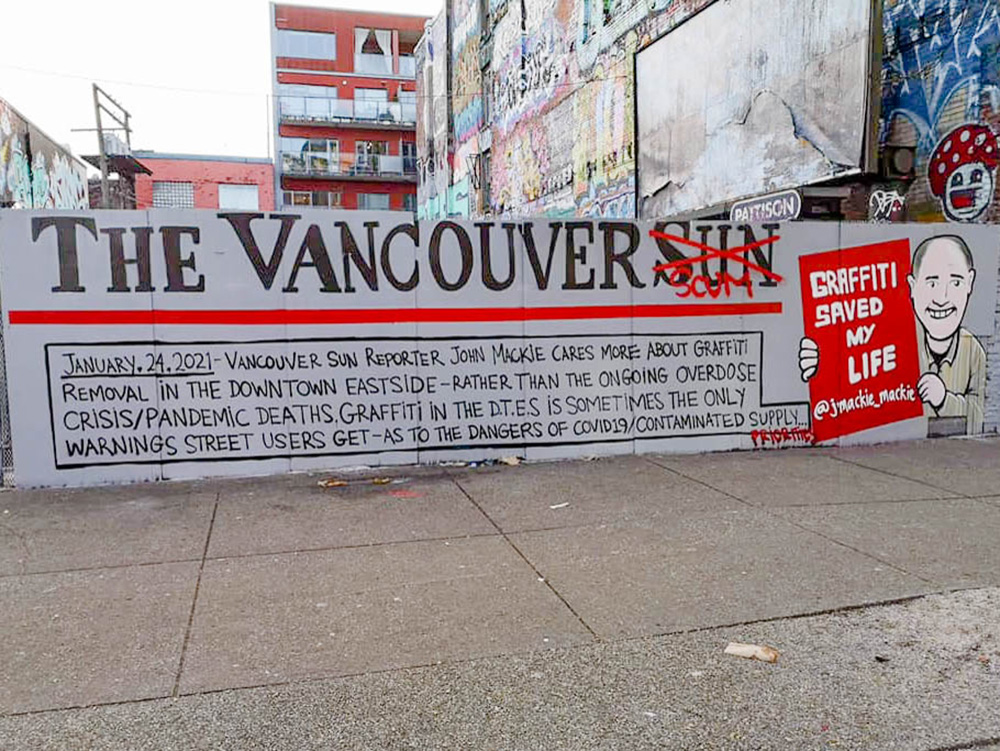A reporter who wrote about graffiti ended up being turned into graffiti himself.
On Sunday, longtime Vancouver Sun reporter John Mackie wrote an article headlined “Graffiti overwhelms Vancouver’s Downtown Eastside and Chinatown.” A print version of the article was titled “‘Chaos breeds chaos.’”
"We’re spending a ton of money on it (cleaning the #graffiti). There’s no enforcement, there’s no responsibility for the people that are doing it. ...social disorder that seems to be taking over the neighbourhood or the community." #DTES #Vancouver #BC https://t.co/iHXPp9i619 pic.twitter.com/LWuplU50ws
— People First Radio (@peoplefirstrad) January 25, 2021
The story drew a spectrum of online responses from it’s “really depressing to see” to “who cares” to denouncing it as “classist reporting” in a time when toxic drugs and COVID-19 are killing Downtown Eastside residents, a view shared by a number of community advocates.
A few of them wanted to write back to Mackie. And instead of a traditional letter to the editor, they decided an article about graffiti deserved a special response.
By Tuesday afternoon a mural was finished at 62 E. Hastings, home to an inhalation tent run by the Overdose Prevention Society and funded by Vancouver Coastal Health.
On the mural, under a masthead of “The Vancouver Scum,” was the message “Vancouver Sun reporter John Mackie cares more about graffiti removal in the Downtown Eastside — rather than the ongoing overdose crisis/pandemic deaths. Graffiti in the DTES is sometimes the only warnings street users get — as to the dangers of COVID19/contaminated supply…. Priorities.”
Included was a cartoon of Mackie himself holding up a sign that says “Graffiti saved my life” with his Twitter handle. It’s a spoof of Mackie’s current profile picture of him holding up a vintage Sun ad.
One of the artists behind the mural was Trey Helten, a manager at the Overdose Prevention Society who’s always enjoyed art but only started doing street art a year-and-a-half ago.
“I don’t even know the guy,” said Helten of Mackie. “I don’t hate him or anything.... Basically, there’s an article every week slandering the Downtown Eastside. John Mackie’s article isn’t different than any other article. I’m very passionate about the neighbourhood. I think I just kind of snapped.”
Mackie’s article walks through some of the tags that have appeared in the Downtown Eastside and adjacent Chinatown during the pandemic and how they are covering up murals and historic buildings.
The article features interviews with a business owner and the head of the Chinatown Business Improvement Association, as well as Sarah Blyth, co-founder of the Overdose Prevention Society, on formal versus informal graffiti.
Helten said the overall tone of the article was against graffiti artists. And it didn’t include information on all the ways graffiti is used in a neighbourhood where many deal with poverty, substance use and health issues and do not have fast access to information.
“As someone who was an entrenched user… for three-and-a-half years I never read the newspaper,” said Helten. “Like for example, I didn’t find out Robin Williams had committed suicide until three, four months after it actually happened. I didn’t have a phone, didn’t have Google, didn’t have news apps, didn’t have newspapers. So graffiti is really important in the Downtown Eastside, for warnings for people who don’t have access to news outlets.”
Graffiti in the neighbourhood has been used for everything from obituaries to crucial warnings about poisoned drugs and ways to prevent the spread of COVID-19.
The Tyee called Mackie, who declined to comment, but said he may address the situation in a future Sun article.
The Sun/Province’s city editor Cassidy Olivier, however, did come to Mackie and the paper’s defence on Twitter.
“We continue to cover the opioid crises,” he wrote. “We’ve done a lot of important work in the community over the decades because it is important. This story had its own merits and is part what is going on. And yet the reporter was attacked.”
But Blyth, despite being interviewed for Mackie’s article, shared on Twitter that she thought his “parachuting” coverage still could’ve included more context.
“People are dying,” she wrote, “we are already at the end of our rope... a little beauty helps.” ![]()
Read more: Municipal Politics, Media
















Tyee Commenting Guidelines
Comments that violate guidelines risk being deleted, and violations may result in a temporary or permanent user ban. Maintain the spirit of good conversation to stay in the discussion.
*Please note The Tyee is not a forum for spreading misinformation about COVID-19, denying its existence or minimizing its risk to public health.
Do:
Do not: